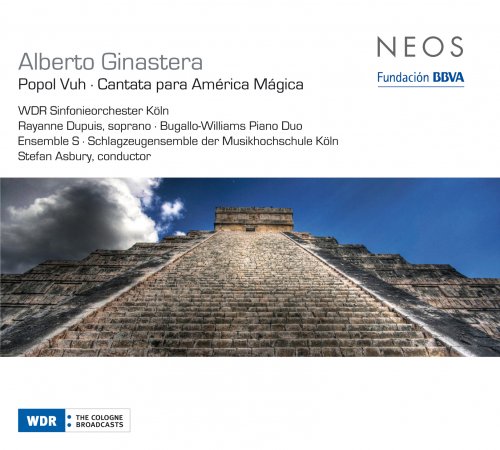
WDR Sinfonieorchester Köln, Stefan Asbury - Ginastera: Popol Vuh (2010)
BAND/ARTIST: WDR Sinfonieorchester Köln, Stefan Asbury
- Title: Ginastera: Popol Vuh
- Year Of Release: 2010
- Label: Neos
- Genre: Classical
- Quality: FLAC (tracks)
- Total Time: 49:37
- Total Size: 202 mb
- WebSite: Album Preview
Tracklist:
Popol vuh, Op. 44 (Alberto Ginastera)
01. I. La Noche de los Tiempos - 00:06:35
02. II. El Nacimiento de la Tierra - 00:04:29
03. III. El Despertar de la Naturaleza - 00:04:55
04. IV. El Grito de la Creacion - 00:00:39
05. V. La Gran Lluvia - 00:02:42
06. VI. La Ceremonia Magica del Maiz - 00:02:39
07. VII. El Sol, la Luna y las Estrellas - 00:03:23
Cantata para America magica, Op. 27 (Alberto Ginastera)
08. I. Preludio y canto a la aurora - 00:04:55
09. II. Nocturno y canto de amor - 00:03:59
10. III. Canto para la partida de los guerreros - 00:02:07
11. IV. Interludio fantastico - 00:03:50
12. V. Canto de agonia y desolacion - 00:05:35
13. VI. Canto de la profecia - 00:03:49
Performers:
Rayanne Dupuis (soprano), Schlagzeugensemble der Musikhochschule Köln, Bugallo-Williams Piano Duo
WDR Symphony Orchestra Cologne, Ensemble S, Stefan Asbury
Popol vuh, Op. 44 (Alberto Ginastera)
01. I. La Noche de los Tiempos - 00:06:35
02. II. El Nacimiento de la Tierra - 00:04:29
03. III. El Despertar de la Naturaleza - 00:04:55
04. IV. El Grito de la Creacion - 00:00:39
05. V. La Gran Lluvia - 00:02:42
06. VI. La Ceremonia Magica del Maiz - 00:02:39
07. VII. El Sol, la Luna y las Estrellas - 00:03:23
Cantata para America magica, Op. 27 (Alberto Ginastera)
08. I. Preludio y canto a la aurora - 00:04:55
09. II. Nocturno y canto de amor - 00:03:59
10. III. Canto para la partida de los guerreros - 00:02:07
11. IV. Interludio fantastico - 00:03:50
12. V. Canto de agonia y desolacion - 00:05:35
13. VI. Canto de la profecia - 00:03:49
Performers:
Rayanne Dupuis (soprano), Schlagzeugensemble der Musikhochschule Köln, Bugallo-Williams Piano Duo
WDR Symphony Orchestra Cologne, Ensemble S, Stefan Asbury
Alberto Ginastera left his massive orchestral piece Popol Vuh, which had been commissioned by Eugene Ormandy, unfinished at his death in 1983, and it was only after it was discovered by pianist Barbara Nissman that it had its premiere in 1989, with Leonard Slatkin and Saint Louis Symphony. A musical reimagining of Mayan creation mythology, it's a monumental piece that viscerally evokes a primitive world using both folk elements and sophisticated modernist techniques. The composer wrote that he was aiming for a "reconstitution of the transcendental aspect of the ancient pre-Columbian world," and the piece is fully successful at capturing that vision with music that is powerfully primal, strange, and darkly beautiful. Although Ginastera never composed the final movement, The Dawn of Mankind, the seventh, The Sun, the Moon, and the Stars, makes a magnificent finale, so the whole work seems integrated and satisfyingly complete. Stefan Asbury leads WDR Sinfonieorchester Köln in a performance that captures both the work's gravity and its dazzling explosiveness.
Ginastera wrote Cantata para América Magica, scored for soprano, 13 percussionists and 2 pianos, in 1960, during the period when his music was largely influenced by serialism and postwar European trends. The pre-Columbian texts are similar in tone to those on which he drew for Popol Vuh, but this work is clearly modernist, and in spite of its colorful use of a massive percussion ensemble, is less emotionally communicative and packs nowhere near the punch of the orchestral work. Soprano Rayanne Dupuis manages the solo part, but she doesn't have a particularly sensuous instrument and lacks the assurance and vocal heft to bring it fully to life. Schlagzeugensemble der Musikhochschule Köln, Ensemble S, and the Bugallo-Williams Piano Duo, led by Asbury, play with astonishing virtuosity. The sound of Neos' SACD is clear and clean, but in the cantata, doesn't always succeed in managing the tricky balance between the soloists and the massive arsenal of percussionists.
Ginastera wrote Cantata para América Magica, scored for soprano, 13 percussionists and 2 pianos, in 1960, during the period when his music was largely influenced by serialism and postwar European trends. The pre-Columbian texts are similar in tone to those on which he drew for Popol Vuh, but this work is clearly modernist, and in spite of its colorful use of a massive percussion ensemble, is less emotionally communicative and packs nowhere near the punch of the orchestral work. Soprano Rayanne Dupuis manages the solo part, but she doesn't have a particularly sensuous instrument and lacks the assurance and vocal heft to bring it fully to life. Schlagzeugensemble der Musikhochschule Köln, Ensemble S, and the Bugallo-Williams Piano Duo, led by Asbury, play with astonishing virtuosity. The sound of Neos' SACD is clear and clean, but in the cantata, doesn't always succeed in managing the tricky balance between the soloists and the massive arsenal of percussionists.
DOWNLOAD FROM ISRA.CLOUD
WDR Sinfonieorchester Köln, Stefan Asbury - Ginastera Popol Vuh (2010).rar - 202.9 MB
WDR Sinfonieorchester Köln, Stefan Asbury - Ginastera Popol Vuh (2010).rar - 202.9 MB
As a ISRA.CLOUD's PREMIUM member you will have the following benefits:
- Unlimited high speed downloads
- Download directly without waiting time
- Unlimited parallel downloads
- Support for download accelerators
- No advertising
- Resume broken downloads


